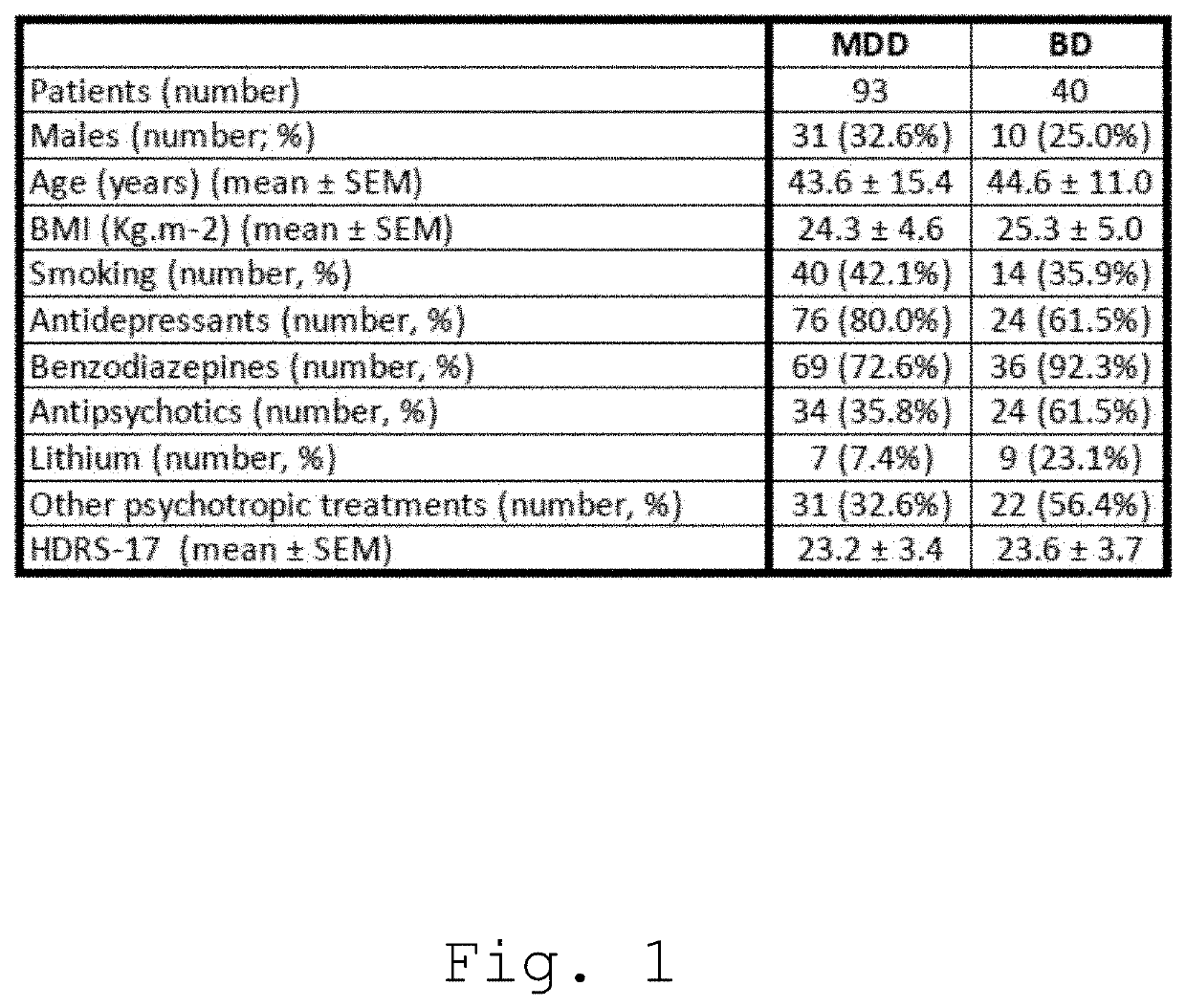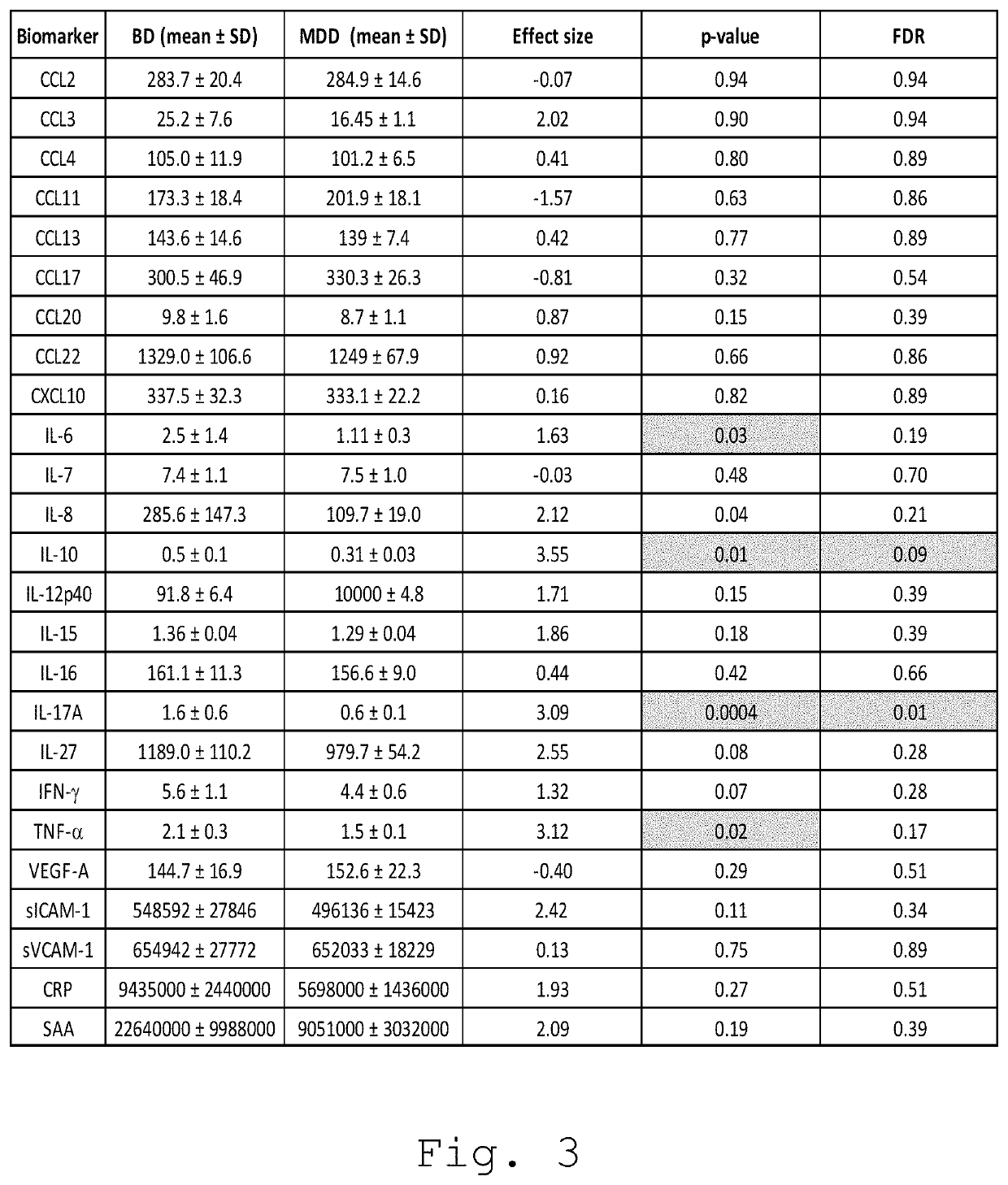A method for differentially diagnosing in vitro a bipolar disorder and a major depressive disorder
a major depressive disorder and in vitro diagnosis technology, applied in the field of in vitro or ex vivo methods for differential diagnosis of bipolar disorder and major depressive disorder, can solve the problems of aggravated illness course, worsening outcome, and being used by a very limited number of general practitioners
- Summary
- Abstract
- Description
- Claims
- Application Information
AI Technical Summary
Benefits of technology
Problems solved by technology
Method used
Image
Examples
example 1
[0057]1. Methods and Material
[0058]Eligible study participants were 148 adults diagnosed with current Major Depressive Episode (MDE) and 100 age- and gender-matched healthy controls from a study registered in ClinicalTrials.gov with ID: NCT02209142. Participants had a clinical evaluation using the Semi-Structured Clinical Interview of the 4th edition of the Diagnostic and Statistical Manual of Mental Disorders (DSM). Patients were recently admitted in a psychiatric unit or have been recently referred to a psychiatrist for a MDE. The diagnosis of MDE was made by skilled psychiatrists based on the DSM-IV criteria of mood disorders and the MDE severity was evaluated by the 17-item Hamilton Depression Rating Scale (HDRS). Patients were included if they scored 19 or higher on the HDRS. Exclusion criteria were a history of substance use disorder in the past 12 months, a diagnosis of schizophrenia, psychotic or schizoaffective disorder according to the DSM-IV, a severe progressive medical ...
example 2
[0074]1. Methods and Material
[0075]1.1 Study Subjects
[0076]A total of 203 adults diagnosed with current MDE were recruited under informed consent. FIG. 7 details the patients clinical characteristics that were considered in this cohort. Participants had a clinical evaluation using the Semi-Structured Clinical Interview of the 4th edition of the Diagnostic and Statistical Manual of Mental Disorders. Patients were recently admitted to a psychiatric unit or had been recently referred to a psychiatrist. The diagnosis of MDE was made by experienced psychiatrists based on the DSM-IV criteria of mood disorders and the MDE severity was evaluated by the IDS-C30. Exclusion criteria were a diagnosis of schizophrenia, psychotic or schizoaffective disorder according to the DSM-IV, a severe progressive medical disease and pregnancy. 203 MDE patients were included in the analyses. Current treatments including use of selective serotonin reuptake inhibitors (SSRIs), tricyclic antidepressants (TCAs),...
PUM
| Property | Measurement | Unit |
|---|---|---|
| threshold | aaaaa | aaaaa |
| concentration | aaaaa | aaaaa |
| energy levels | aaaaa | aaaaa |
Abstract
Description
Claims
Application Information
 Login to View More
Login to View More - R&D
- Intellectual Property
- Life Sciences
- Materials
- Tech Scout
- Unparalleled Data Quality
- Higher Quality Content
- 60% Fewer Hallucinations
Browse by: Latest US Patents, China's latest patents, Technical Efficacy Thesaurus, Application Domain, Technology Topic, Popular Technical Reports.
© 2025 PatSnap. All rights reserved.Legal|Privacy policy|Modern Slavery Act Transparency Statement|Sitemap|About US| Contact US: help@patsnap.com



